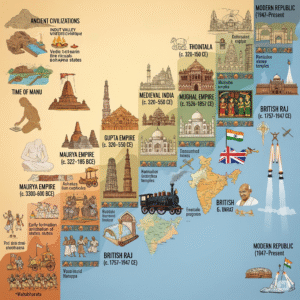 Ever scrolled through a history timeline and felt like it was just a blur of names and dates? India’s story is anything but. It’s a saga spanning millennia, filled with legendary kings, philosophical movements, and monumental shifts that have shaped not just a nation, but a global culture. Let’s take a quick, engaging tour of how India evolved from ancient kingdoms to the vibrant republic it is today.
Ever scrolled through a history timeline and felt like it was just a blur of names and dates? India’s story is anything but. It’s a saga spanning millennia, filled with legendary kings, philosophical movements, and monumental shifts that have shaped not just a nation, but a global culture. Let’s take a quick, engaging tour of how India evolved from ancient kingdoms to the vibrant republic it is today.
The Dawn of Civilizations: From Manu to Mahabharata
Long before social media, the Indian subcontinent had its own thriving networks. The land, once known as Jambudvipa, was first governed by fourteen rulers called the Manus. It’s from them that we get the name Manavulu (humans). It’s kind of like how we get our word for “mankind”—it’s a nod to our shared beginnings.
Later, a great king named Bharata ruled so justly that the country was named Bharat Khanda in his honor. Think of him as the original nation-builder, the first person to unite the country under a single, strong identity.
Ancient India wasn’t a single empire, but a collection of kingdoms, most famously belonging to two main dynasties: the Surya Vamsha (Solar dynasty) and the Chandra Vamsha (Lunar dynasty). These weren’t just about power; these kings lived by a code of righteousness, or dharma. The Surya Vamsha gave us icons like Sri Rama, whose reign was so perfect that people still use the term Rama Rajya to describe an ideal society. The Chandra Vamsha, meanwhile, is famous for the Yadavas, Kauravas, and Pandavas. Their story, a struggle between good and evil, is immortalized in the Mahabharata.
The Classical Age & The Rise of Empires
After the legendary conflicts, the country fractured. But soon, new empires rose to power, bringing fresh ideas and monumental change. The Magadha kingdom became a major player around the 6th-4th centuries BCE. Then came the Maurya dynasty, founded by Chandragupta Maurya. His grandson, Ashoka the Great, was a game-changer. He expanded the empire all the way to the Kaveri River and, after a change of heart, became a huge proponent of peace and Buddhism.
This era also saw the emergence of various dynasties in the south, such as the Satavahanas, Rashtrakutas, Cholas, and Pandyas. The Satavahana ruler Shalivahana even started a new calendar, the Shalivahana Shaka, in the first century CE.
Fast-forward to the 15th-16th centuries, and the Vijayanagara Empire dominated South India. Its most famous ruler, Sri Krishnadevaraya, was a patron of the arts, and his court was a hub for eight great poets, the Ashta Diggajas. His reign is considered a golden age for Telugu literature and culture.
The Arrival of a New World Order
By the 16th century, foreign powers—the Portuguese, French, and English—had their eyes on India’s wealth. They arrived as traders, but soon realized that India’s many small, warring kingdoms were ripe for the taking. The British, through the East India Company, outmaneuvered their rivals and gradually took control of the entire subcontinent.
British rule brought new technologies like the telegraph, postal services, and railways. But it also came at a steep cost: the suppression of local languages and the loss of sovereignty. This period of foreign rule, or paratantra dasyam, ignited a spark in Indian leaders.
The Struggle for Freedom and a New Nation
In response to British rule, Indian leaders founded the Indian National Congress to fight for independence. The fight was long and difficult, marked by countless sacrifices and a relentless struggle against oppression.
The movement truly gained momentum under Mahatma Gandhi, who championed a unique form of resistance based on non-violence and satyagraha (civil disobedience). This peaceful yet powerful approach ultimately forced the British to leave without a bloody war.
India finally gained its freedom on August 15, 1947. However, the victory was bittersweet. The demand for a separate Muslim state led to the partition of India, creating Pakistan.
On January 26, 1950, India officially became a sovereign democratic republic. This was a monumental moment, as the country adopted its own constitution, written by its own people. Today, India is a federal republic, with power divided between a central government and its many states. The country’s head is the President, and the government is led by the Prime Minister.
From the moral epics of the Surya and Chandra Vamshas to the non-violent revolution of Gandhi, India’s history is a living lesson in resilience, identity, and the timeless pursuit of justice. It’s a journey that continues to inspire and evolve every single day.
